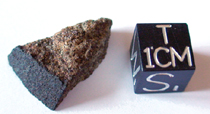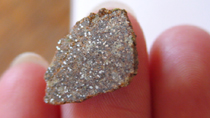Acapulcoites
The name of this small group of primitive achondrites is derived from
its only witnessed fall, the meteorite of Acapulco that fell in Mexico in
1976. Since its composition is nearly chondritic, Acapulco was initially
classified as an anomalous chondrite, although it does not contain any
relict chondrules. However, when similar meteorites were subsequently
found, the acapulcoite group was formed to describe a distinct class of
primitive achondrites. Acapulcoites mark the transition between primordial
chondritic matter and more differentiated rocks. The acapulcoite group
presently comprises 12 members, if one excludes probable pairings.
Acapulcoites are composed primarily of fine-grained olivine,
orthopyroxene, minor plagioclase, nickel-iron metal, and the iron sulfide,
troilite. They have mineral compositions that are intermediate between
those of E and H chondrites, but they exhibit a characteristic oxygen
isotopic pattern distinct from all other known chondrite groups.
Importantly, some acapulcoites have been shown to contain a few relict
chondrules such as the meteorite of Monument Draw, Texas, and one member
actually exhibits an abundance of distinct chondrules - our recent find
from Tissemoumine, Morocco, officially named NWA 725. This unique
acapulcoite is actually a scientific sensation, and it is one of our best
finds. The presence of distinct chondrules within NWA 725 attests to the
fact that the acapulcoites represent an extremely primitive group, a true
transition between chondrites and achondrites. It is thought that they
originated on the same parent body as the closely related lodranites,
another class of primitive achondrites.
|
Acapulco Witness Fall : 1976 August
11, 11hrs
TKW 1914 gr
Mexico, Guerrero
Acapulcoite
|
|
|
 
|
|
|
|
Acapulco 00
Type specimen for the acapulcoite group !!!
endcut with nice crust and an open window
SOLD price on
request |
|
|
|
|
|
|
|
Acapulco 01
Type specimen for the acapulcoite group !!!
nice slice
0.92gr SOLD
|
|
|
|
 
|
|
|
|
|
|
|
|
|
|
|
|
|
|